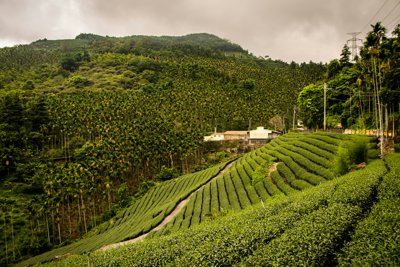October 2006
McDonald’s and Greenpeace becoming friends?
Tree nurseries springing up in dense forest?
These are two matters reported on recently by the BBC (27 September 2006) and the Guardian (2 August 2006) but why are tree nurseries a necessity and what has forced two opposing forces to form an unlikely alliance?
Figures for 2004/2005 show that the rate of forest clearance in the Amazon was the second highest on record.
With deforestation now widely regarded as a major cause of climate change, what drove Brazil to cut down 10,000 square miles of forest? What will happen in the future if current rates of removal continue? And what are new developments are occurring in the region?
Record rates of deforestation?
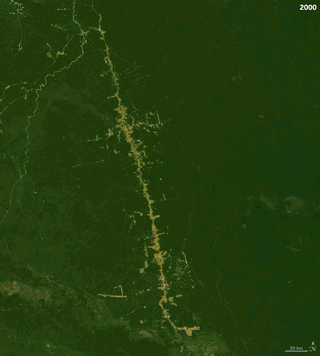
During the last eight years, Brazil has lost an area of tropical rainforest the size of England and Wales. Nearly 20% of the forest – which originally covered 4.1 million square kilometres – has been removed. The world’s rainforests have long been in retreat, as growing populations have cleared forest to create farm land or produce hardwood timber for export. During the last few years, however, much of the accelerated removal of Brazil’s forest can be linked to a single phenomenon: the rise of soya bean production. Between 1995 and 2004, the area of deforested land cultivated with soya increased by 77 per cent in the centre-west of Brazil. Last year, Brazil produced more than 50 million tons of soya across nearly 23 million hectares, an area about the size of the United Kingdom.
The use of soya (Guardian, 24 July 2006)
The soya bean has been grown in China and used in different ways for thousands of years but almost half the world's production is now in the US, which produces 70m tonnes a year. Other leading producers are Argentina, China, India and, increasingly, Brazil, which is expected to overtake US output within a few years. The bulk of the crop is solvent extracted for vegetable oil, with soya meal used increasingly to feed chickens, pigs and cows for meat products. A tiny proportion is consumed directly as human food. Apart from foods, soya beans are now used in industrial products such as oils, soap, cosmetics, resins, plastics, inks, crayons, solvents, vodka and biodiesel. Clearing land for industrial soya farming is taking over from timber as the major driver of forest loss in some regions.
The Independent (20 May 2005) and the BBC Radio 4 Today programme (May 2005) both reported that nearly half of 2003’s2003’s forest removal took place in the state of Mato Grosso. The state governor Blairo Maggi also happens to run the world’s largest soya bean production company. Maggi is known locally as “O Rei da Soja” (the King of Soya). During 2003, his first year as governor, the rate of deforestation in Mato Grosso more than doubled. His company Gruppo Maggi is considered to be the world's largest individual soya producer, grossing $600m last year. He now intends to triple the amount of land planted with soya beans during the next decade in Mato Grosso state.
The soya boom
The soya boom has dramatically stepped up the pace of rainforest destruction in Brazil. It first showed up in the deforestation figures for 2003. After falling or staying steady for eight years, the rate of destruction suddenly leapt by 40 per cent in 2003, up from 18,170 sq km to 25,500 sq km. According to The Independent newspaper, events in the UK are partly responsible for what has happened!
It began on the back of the BSE crisis in Britain, when the feed given to cattle suddenly became a matter of intense public concern. Cattle feed producers around the world switched to soya as an untainted source. The boom was intensified by the fact that Brazil - in contrast to the US and Argentina - did not go down the GM route in its agriculture, so when most European countries went GM-free, it was from Brazil that they sought their soya bean supplies. Europe now imports 65 per cent of its soya from Brazil. A further impetus to the boom is coming from China, whose emerging middle class wants to eat more and more meat - so the demand for animal feed is soaring.
Source: The Independent, 20 May 2005, page 2.
Deforestation in South America
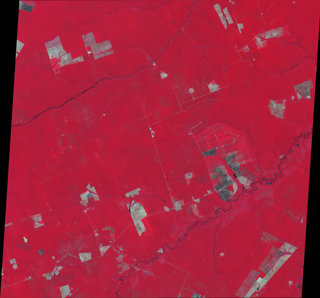
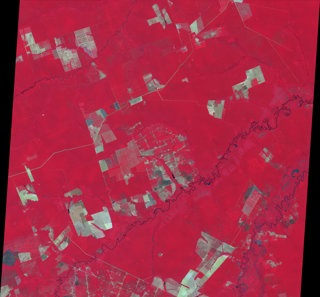
This pair of images shows large clearings made in the Amazon Rainforest in the state of Mato Grosso, Brazil, between 2001 (left image) and 2006 (right image). A blue river meanders along the bottom right corner of the images, surrounded by forest, which appears red. In 2001, a few large clearings (blue-gray rectangles) appear on the north and south sides of a road that cuts northeast across the upper left corner of the image. By 2006, the area cleared in the scene appears to have roughly tripled, but the reddish tinge in some of the clearings indicates vegetation of some kind is growing there. In other places, the ground is totally bare.
Images by Robert Simmon, based on data provided by the NASA/GSFC/METI/ERSDAC/JAROS, and U.S./Japan ASTER Science Team
Over the last century, there has been an increasing drive to utilize the South American lowland forests commercially for crop-growing and ranching, in response to population growth and a need to increase exports to pay off national debt. In Costa Rica, the wooded area was reduced from 67% primary forest in 1940 to only 17% in 1983. Worst-hit has been the Atlantic rainforest on the south-eastern coast of Brazil. Now almost totally removed, primary forest currently occupies less than 2% of its original area. Meanwhile, on the western side of the Andes, the exceptionally species-rich Peruvian and Colombian forests are now being cleared rapidly, with coca (cocaine) and opium poppy cultivation being among the major incentives.
The process of forest conversion to other land uses in South America has been increased by planned projects that have opened up previously inaccessible regions. In the southern Amazonian state of Rondonia, the Brazilian government built a road (BR-364) which allowed large scale migration of landless farmers into the region. The result is that much of the primary forest in Rondonia has now been destroyed. Other government-backed projects in Brazil have resulted in the large-scale clearance of rainforest (e.g. for the use of wood as iron smelter fuel in the Carajas region in the north-east) and substantial areas of forest have been flooded by the building of hydroelectric dams along the Amazon tributaries.
Worryingly, the destruction of the rainforest comes at a time when scientists are finding that levels of unknown species in the rainforest are higher than previously suspected. 80% of all insects recently found living in the forest canopy are entirely new to science! Currently, 137 species are estimated to become extinct every day due to forest clearance, before they can be documented and studied.
Tropical Rainforest (TRF): the facts
- Location
The tropical rainforest (TRF) is found between 10°N and 10°S latitude, at elevations below 1,000 metres. The global distribution of equatorial rainforest is closely tied to the warm, moist climates that occur near to the Equator. There, the intense energy input from the sun produces the intertropical convergence zone (the ITCZ), a convection zone of rising air that loses its moisture as frequent, intense rainstorms. The lack of seasons results in consistently high monthly temperatures, generally between 26°C and 28°C: these are optimum conditions for plant growth.
- Regional forest formations
(1) Amazonian (Amazonia into Central America)
(2) African (Zaire Basin and West Africa; also Madagascar)
(3) Indo-Malaysian (west India, southeast Asia, New Guinea & Australia)
- Net primary productivity (NPP)
The TRF has the highest NPP of any terrestrial biome at 2.2 kg/m2/year. This is due to the all-year growth of deep rooted tall trees and the abundant undergrowth. TRF contributes 40% of global NPP.
- Biomass
The biomass of the TRF is 40 kg/m2. It consists of a continuous canopy at 30 metres, with emergents stretching up to 50 metres. The field layer of herbs and ferns have huge drip-tip leaves for light collection (only 1% of light reaches the forest floor).
- Soils
The soils beneath the TRF are ferrallitic: old, deeply weathered and lacking in primary minerals. They are dependent on continued nutrient recycling from leaf litter and often degrade quickly if forest is cleared, with a laterite duricrust sometimes forming when the surface is exposed to sunlight.
What are the causes of deforestation in Brazil?
Agents of deforestation operate in two opposing strata of the economy of Brazil. Firstly, forests are harvested by large commercial firms for timber exports, or are removed to provide land for major agribusiness or mining operations. Secondly, at a near-subsistence level, growing numbers of landless rural people need to clear areas of forest so that they can grow crops or collect firewood. This pattern is repeated throughout other equatorial forest regions in Africa and Indonesia.
Agribusiness and commercial clearances
The export of tropical hardwood has been occurring for centuries and continues today, despite attempts to restrict imports by countries like the UK (although Wyevale, the UK’s largest garden centre group, was recently found to be selling furniture made with rainforest wood). In addition to commercial clearances for timber harvesting, there are other large-scale land uses that require forest removal:
(1) Forests are cleared to create land for cattle ranching, or to grow commercial crops such as soya beans in Brazil’s Mato Grosso state (in neighbouring Costa Rica, around one-third of all cleared rainforest land is used for cattle ranching).
(2) Brazil’s Grande Carajas Programme involved the establishment of iron mines and aluminium plants where virgin forest once stood.
(3) Finally, the construction of roads, such as the Trans-Amazon Highway, is necessary in order to link newly-commercialised regions of rural Brazil with global markets. This inevitably leads to further swathes of forest being removed.
Subsistence and survival clearances
At the other extreme, the growth of population in Brazil (now 188188 million) has intensified pressure on forested areas to provide land for farming, housing and timber for fuel for the poor of Brazil. On the fringes of urban settlements in the Amazon basin, such as Manaus, forest is cleared to provide land for informal (shanty) dwellings by the poor of the city. As many as 20 million people are now living in settlements along the Amazon and its tributaries. Of these, 400,000 are landless farmers, all currently looking for new land where they can cultivate subsistence crops. Further deforestation is clearly inevitable.
What are the local and global consequences of deforestation?
Environmental impacts
The Amazon forest is sometimes called “the world's lungs" because its trees produce much of the world's oxygen, while soaking up carbon dioxide that would otherwise raise temperatures globally by contributing to the greenhouse effect. Forest removal is thought to release around 6 x1015 grams of carbon emissions every year. This is a major contributing factor to climate change, with all of the associated consequences of retreating glaciers, rising sea levels and temperature increases that are now being monitored across the world. Additionally, the increase in albedo rate recorded across large areas of deforested land may lead to changes in global weather patterns as atmospheric heat flux is modified.
As well as these global concerns, environmental impacts are also experienced locally. Where the tree canopy has been removed, daily convectional rain can wash soils away, either through sheet wash or gullying. This in turn contributes to a greatly increased sediment load in many of the Amazon’s tributaries, changing the temperature of the water and modifying aquatic food webs. Alternatively, soils can suffer in a different way through laterite formation. The process of laterization involves the growth of an iron or aluminium-rich hardened duricrust when soils are exposed to direct sunlight, following the removal of the forest canopy. This renders them agriculturally useless.
Social impacts
The Brazilian rainforest is home to four hundred indigenous tribes, such as the Yanomami people. Although their rights to live there are protected by law, illegal logging now threatens the survival of the few remaining isolated tribes. The loggers themselves carry diseases such as measles or chicken pox, from which the indigenous people often lack immunity. In the past, many have died of illness as a result of contact with outsiders. The loss of the rainforest further jeopardises the survival of these people as they have no option but to migrate to cities in search of work, despite lacking the basic skills and literacy required for survival in an urban environment.
Finally, it is worth noting that the health and welfare of the entire planet is dependent to some extent upon the survival of the rainforest. The TRF is widely recognised as a major resource on account of its vast genepool. Millions of plant, insect and animal species contain genetic material that might one day be harvested to provide vital medical resources. Already, humanity has extracted ingredients from the rainforest biomass for the treatment of leukaemia, Hodgkin’s disease and contraceptive pills. In addition, strychnine, quinine, curate, plant oils, gums, resins, tannin, rubber and dyes have all been retrieved from this region. There is no telling what potential resources may be lost if species are driven to extinction before there has been time to study them.
Decision-making - should logging be allowed to continue?
Different perspectives on rainforest removal
Luiz da Silva (President of Brazil, known as “Lula”)
“The Amazon can’t be treated like it was something from another world, untouchable, in which Brazil’s people don’t have the right to benefit.”
Blairo Maggi (millionaire soya farmer)
"To me, a 40 per cent increase in deforestation doesn't mean anything at all, and I don't feel the slightest guilt over what we are doing here. We are talking about an area larger than Europe that has barely been touched, so there is nothing at all to get worried about."
Everton Vargas (Brazil’s Foreign Minister)
“Promoting preservation at the same time when promoting economic growth and better social conditions is a very complex challenge.”
The Independent newspaper (editorial comment)
“This indefensible practice [logging] goes on… President Lula has done little to curtail the activities of loggers. Much of the logging that goes on is by gangsters, seemingly beyond the reach of the law. Indeed, the murder earlier this year of the anti-logging campaigner Dorothy Strang suggests these groups are getting bolder… It is in the power of the European Union to ban the import and sale of illegally logged timber. They should do so without delay. If this rate of deforestation continues, the consequences will be disastrous: indigenous tribes will be made homeless, entire species will be wiped out and one of the world’s great absorbers of CO2 will be destroyed, intensifying climate change.”
Source: The Independent (20 May 2005)
The case against logging
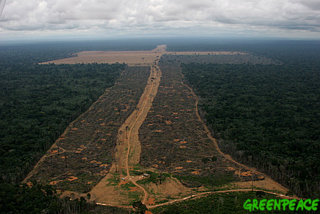
In the previous section, the local and global consequences of deforestation, the negative environmental and social consequences of deforestation were set out. In addition to local soil erosion - as well as concerns over the welfare of indigenous people - the global significance of the tropical rainforest was explained: it is a major carbon sink, keeping atmospheric carbon dioxide levels down. Removal of the forest therefore has implications for people living everywhere, not just in Brazil. However, many Brazilians cannot see an alternative way to develop their economy and society without continued forest removal. What are their arguments in favour of continued logging?
The case for continued logging
(1) Timber revenues Timber, especially hardwood, is a valuable resource that can easily be harvested and exported to help feed a growing population. 10 million people are unemployed in Brazil, and 22% live below the poverty line. The Brazilian economy needs to grow if these people are to gain a decent quality of life. Hardwood exports can help support economic growth.
(2) Commercial agriculture revenues Farming is the country's number one export earner but needs to expand further if the current government of President Lula is to earn more foreign exchange for debt payments. Brazil over-borrowed in the past from commercial banks and the International Monetary Fund (IMF). Soya bean exports – the cause of the recent rise in deforestation – can assist with debt repayment.
(3) Land to live on A growing population requires land to live on. In the past, much of the UK was originally covered with forest but this was removed as the nation developed (forest land coverage in England reached an all-time low of 3% in 1919, as trees were cleared to make room for commercial agriculture and growing urban centres). As Brazil’s population modernises, they too will want the benefits of transport infrastructure (roads and airports), health and education facilities, services and shops. All of these functions require land. Can Brazilians now be denied what other countries like the UK have taken for granted in the past – namely, the right to clear forest to make living room?
(4) Lack of alternatives Brazil now has a population of 188188 million people. Currently growing at 1.5% per annum, this total could easily double by 2050. Although southern Brazil (the Sudeste region of Rio and Sao Paulo) is industrialising rapidly, alternative economic development strategies in the rain forest territories, where 20 million people now live, are very limited. If growing numbers of Amazonian Brazilians are to experience an improved quality of life, then further deforestation is inevitable unless mass migration takes place away from the Amazon region. However, the southern region is over-crowded already – with conditions in the favelas of Rio and Sao Paulo notoriously poor. To save the rainforest, must more people be forced to migrate south, thereby making conditions even worse for everyone else already living there?
Future developments in the Amazon rainforest?
At the end of July 2006, some of the world’s most powerful companies took a step to reduce the damage of soya cultivation in the rainforest. An unlikely union of Greenpeace, McDonald’s and leading supermarkets of Europe, successfully pressured multinational US based commodities brokers into signing a two-year moratorium on buying soya from newly deforested land in the Amazon, pushing a multi-million dollar industry towards a more sustainable future.
A three year investigation by Greenpeace uncovered a supply chain beginning with illegal rainforest destruction and ending in the fast food restaurants and supermarkets of Europe. Following the publication of the report in April 2006, the companies feared a consumer backlash and urged traders to clean-up their supply chain. The large US-based traders, including Gruppo Maggi, signed an agreement not to buy or produce soya from newly cleared rainforest or from areas where farming is practised illegally. Traders will have to ensure they obtain soya from farmers who follow the environmental laws of Brazil that state 80% of their land is retained, whilst the remaining 20% can be used for agricultural purpose (very few farmers follow this). Where rainforest has already been cleared and land used illegally, farmers will be expected to follow systems that ensures the law can now be followed.
Environmental campaigners in Brazil welcomed the moratorium, but warned it would be hard to undo the damage, although this was a good start. For the rainforest to remain protected and free from soya exploitation there will need to be large investments and continual monitoring to ensure the agreement is not broken.
The moratorium demonstrates the influence consumers can have on events thousands of miles away on large multi-nationals. The question of whether this is being done for the benefit of the environment, or for the benefit of the multinationals profits, remains to be seen. How this moratorium will benefit the rainforest can only be observed over time. (Guardian 24 July 2006; Guardian 2 August 2006; BBC 24 July 2006).
KS3 links and A-level practice questions
This article can be used for investigating brazil at KS3
The comparison with the UK is probably most useful (in part 4 – we lost our forest by 1919, etc.)
A Level population, migration and rural settlement
With reference to named examples, describe and explain the environmental consequences of a rapidly growing population.
(8 marks)
With reference to named examples, describe and explain the environmental consequences of migration.
(8 marks)
Examine the impact population growth may be having on rural environments.
(6 marks)
A Level ecosystems and development (extended writing)
Analyse the importance of human activity as a factor influencing the distribution of your named FOREST biome.
(20 marks)
Examine the environmental consequences of rapid economic growth.
(20 marks)
Examine the processes which may cause biodiversity loss.
(10 marks)
A Level Synoptic papers
Can ecological concerns and economic development be reconciled to provide a sustainable future for the people of Brazil? Questions for exam practice include:
1. Describe how deforestation is changing the distribution pattern of Brazil’s forests.
(10 marks)
2. Describe and explain the environmental and social consequences of rapid rates of forest removal.
(12 marks)
3. Explain the economic and demographic causes of tropical rainforest removal.
(12 marks)
4. To what extent do you agree that further forest losses are inevitable in Brazil?
(16 marks)
Total: 50 marks
